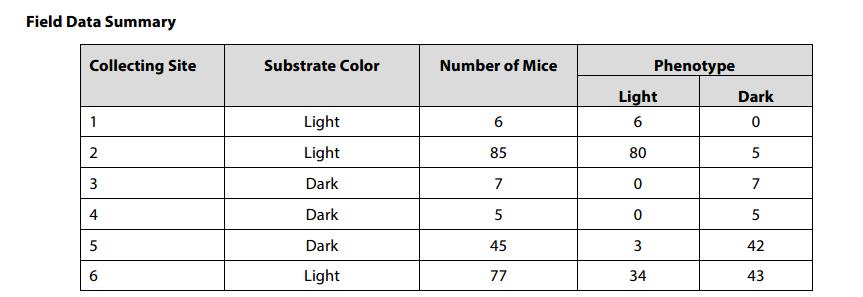

- #Hhmi color variation in the rock pocket mouse answers skin
- #Hhmi color variation in the rock pocket mouse answers series
Most rock pocket mice that live in areas covered by dark-colored lava rocks, however, are dark in color. Rock pocket mice that live in areas with a light-colored granite substrate are usually sandy in color. Mukkaw Biointeractive Population Dynamics Answer Key HHMI Rock Pocket Mouse. Location B became covered in dark-colored volcanic rock, which means. Light-colored mice had a selective advantage because. include Originally, location B had a sandy-colored soil. Ann Brokaw presents three BioInteractive resources she uses to support the short film 'Natural Selection and Adaptation.' The activities focus on the MC1R ge.

#Hhmi color variation in the rock pocket mouse answers skin
Motivated by the wealth of data on the genetics, biochemistry, and molecular biology of the pigmentation process, we have used a candidate-gene approach to identify the genetic basis of adaptive coat color variation in C. The rock pocket mouse is an excellent model organism to study geographic variation in phenotype within a single species. The Biology of Skin Color HHMI BioInteractive African Wildlife Case Studies. Write a scientific summary that describes changes in the rock pocket mouse populations at location B. Dice and Blossom (1937) suggested that this crypsis is an adaptation to avoid predation. The dark-colored mouse is more vulnerable to predators in light-colored environments, such as sandy deserts. As shown in the animation, mice that blend in with their surroundings are harder for owls and other predators to see. In the sequence of time, this area this illustration represents is: 1st (oldest) 2nd 3rd 4th (most recent) Circle the appropriate number. Rock pocket mice can have either light-colored or dark-colored fur. HHMI Color variation over time in rock pocket mouse populations: Student handout of 1. intermedius coat color typically matches the color of the rocks on which the mice live the dorsal pelage varies from a light, sandy color for populations found on some granites to a dark, nearly black color for populations found on basalt lava flows. HHMI Color variation over time in rock pocket mouse populations: Student handout of 7. This activity provides an introduction to natural selection and the role of genetic variation by asking students to analyze illustrations of rock pocket mouse.

#Hhmi color variation in the rock pocket mouse answers series
In a series of classic studies in mammalian evolutionary biology, Sumner (1921), Benson (1933), and Dice and Blossom (1937) described striking coat color variation in the rock pocket mouse, Chaetodipus intermedius, in the deserts of Arizona and New Mexico.


 0 kommentar(er)
0 kommentar(er)
